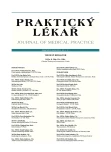Physical activity of patients with coronary heart disease in a home-based rehabilitation program measured by accelerometer
Authors:
J. Bajorek 1; I. Buriánková 1; H. Cypriánová 2; V. Drbošalová 2; J. Mitáš 2; E. Sovová 3
Authors‘ workplace:
I. interní klinika, FN a LF UP Olomouc
Přednosta: doc. MUDr. Miloš Táborský, CSc., FESC, MBA
1; Centrum kinantropologického výzkumu, Fakulta tělesné kultury UP Olomouc
Vedoucí: prof. PhDr. Karel Frömel, DrSc.
2; Klinika tělovýchovného lékařství, FN a LF UP Olomouc
Přednostka: doc. MUDr. Sovová Eliška, PhD., MBA
3
Published in:
Prakt. Lék. 2011; 91(6): 332-336
Category:
Of different specialties
Overview
The aim of the study was to assess energy expenditure in IHD patients during a home-based cardiac rehabilitation program. Using the ActiGraph accelerometer, habitual physical activity was measured prior to the rehabilitation program in 54 men and 7 women who gave consent to participate. Consequently, the measurement was repeated in 31 men and 3 women who remained in the program for 3 months.
Estimated energy expenditure was calculated using a combination of the Freedson equation and work-energy theorem.
The habitual physical activity of our sample was high – 526.1±175.0 kcal (2209.6±735.0 kJ) – and sufficient to prevent IHD. Thus, we can conclude that higher participation in and compliance with home-based cardiac rehabilitation was found in habitually active patients who get less benefit from it.
The limitation of our study is relatively low compliance to accelerometer attendance and controversial application of the Freedson equation to the general population and various physical activities.
Key words:
coronary disease, exercise therapy, ambulatory monitoring.
Sources
1. Aoyagi, Y., Shephard, R.J. Steps per day. Sports Med. 2009, 39, p. 423-438.
2. Balady, G.J., Williams, M.A., Ades, P.A. Core Components of Cardiac Rehabilitation/secondary prevention programs: 2007 Update a scientific statement from the American Heart Association exercise, cardiac rehabilitation, and prevention committee, the council on clinical cardiology; the councils on cardiovascular nursing, epidemiology and prevention, and nutrition, physical activity, and metabolism; and the American Association of Cardiovascular and Pulmonary. Circulation 2007, 115, p. 2675-2682.
3. Bassett, D.R. jr, Ainsworth, A.M., Swartz, S.J. et al. Validity of four motion sensors in measuring moderate intensity physical activity. Med. Sci. Sports Exerc. 2000, 32, S471–S480.
4. Ferguson, E.E. Cardiac rehabilitation - an effective and comprehensive but underutilized program to reduce cardiovascular risk in patients with CVD. US Cardiovascular Disease 2006 [on-line]. Dostupné na http://www.touchcardiology.com/files/article_pdfs/ferguson.pdf.
5. Freedson, P.S., Melanson, E., Sirard, J. Calibration of the computer science and applications, Inc. accelerometer. Med. Sci. Sports Exerc. 1998, 30, p. 777-781.
6. Hatano, Y. Use of the pedometer for promoting daily walking exercise. ICHPER 1993, 29, p. 4-8.
7. Chaloupka, V., Siegelová, J., Špinarová, L. Rehabilitace u nemocných s kardiovaskulárním onemocněním, Doporučení ČKS. Cor Vasa 2006, 48(7-8), K127–K145.
8. Jolliffe, J., Rees, K., Taylor, R.R.S. Exercise-based rehabilitation for coronary heart disease (Review). Cochrane Database Syst. Rev. 2001, (1), CD001800.
9. Jolly, K., Taylor, R.S., Lip, G.Y., Stevens, A. Home-based cardiac rehabilitation compared with centre-based rehabilitation and usual care: a systematic review and meta-analysis. Int. J. Cardiol. 2006, 111, p. 343-351.
10. Leon, A.S., Sanchez, O.A. Response of blood lipids to exercise training alone or combined with dietary intervention. Med. Sci. Sports Exerc. 2001, 33(6), S502-S515.
11. Máček, M., Máčková, J., Smolíková, L. Počet kroků jako ukazatel zdatnosti. Medicina sportiva 2010, 19(2), s. 115-120.
12. Meijer, G.A., Westerterp, K.R., Verhoeve, F.M.H. et al. Methods to assess physical activity with special reference to motion sensors and accelerometers. IEEE Trans. Biomed. Eng. 1991, 38, p. 221-228.
13. Savagem P,D,, Brochum M,, Scottm P,, Adesm P,A. Low caloric expenditure in cardiac rehabilitation. Am, Heart J. 2000m 140, p. 527-533.
14. Schairer, J.R., Kostelnik, T., Proffitt, S.M. et al. Caloric expenditure during cardiac rehabilitation. J. Cardiopulm. Rehabil. 1998, 18, p. 290-294.
15. Schuler, G.R., Hambrecht, G., Schlierf, J. et al. Regular physical exercise and low-fat diet. Effects on progression of coronary artery disease. Circulation 1992, 86, p 1-11.
16. Vojáček, J. Doporučení pro provádění koronarografického vyšetření. Cor Vasa 1998, 40(5), K171-K174.
17. Wasserman, K., Hansen, J.E., Sue, D.Y. Principles of exercise testing and interpretation. 2nd ed. Philadelphia: Lea-Febiger 1994, p. 62-64.
18. Wasserman, K., Hansen, J.E., Sue, D.Y. Principles of exercise testing and interpretation. 2nd ed. Philadelphia: Lea-Febiger 1994, p. 112-119.
19. Whelton, S.P., Chin, A., Xin, X. et al. Effect of aerobic exercise on blood pressure: a meta-analysis of randomized, controlled trials. Ann. Intern. Med. 2002, 136(7), p, 493-503.
20. Zhang, K., Werner, P., Sun, M. et al. Measurement of human daily physical activity. Obes. Res. 2003, 11, p. 33-40.
Labels
General practitioner for children and adolescents General practitioner for adultsArticle was published in
General Practitioner

2011 Issue 6
- Memantine Eases Daily Life for Patients and Caregivers
- Metamizole vs. Tramadol in Postoperative Analgesia
- Metamizole at a Glance and in Practice – Effective Non-Opioid Analgesic for All Ages
- Memantine in Dementia Therapy – Current Findings and Possible Future Applications
- What Effect Can Be Expected from Limosilactobacillus reuteri in Mucositis and Peri-Implantitis?
Most read in this issue
- History and present status of surgical treatment of lung tuberculosis
- Inflammatory back pain – when should be a spondylarthritis considered?
- Vasovagal syncope
- The problem of nutrition in oncology patients
